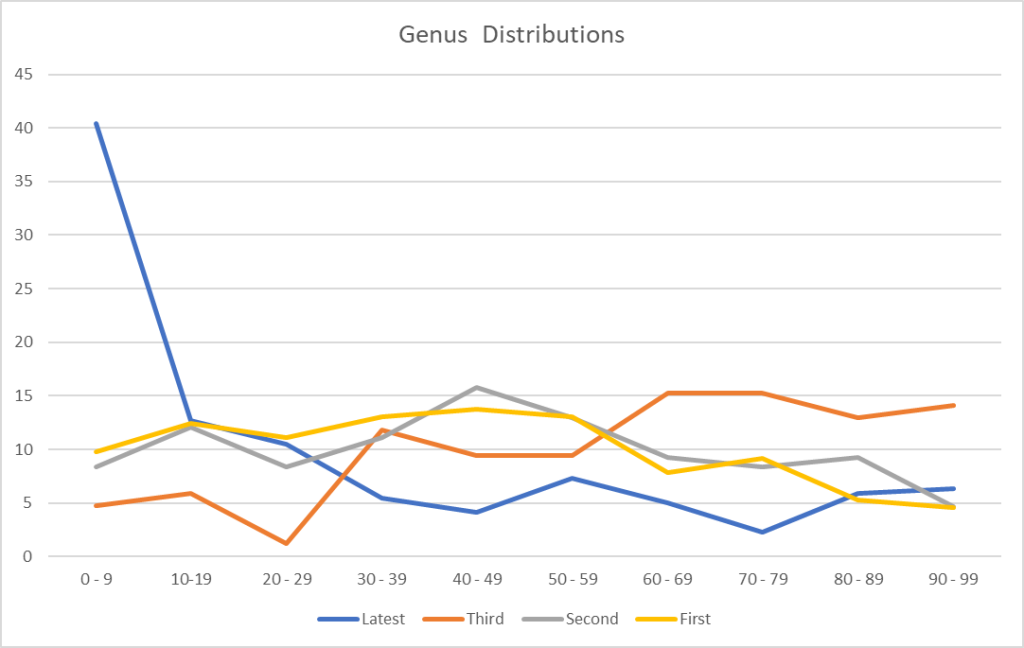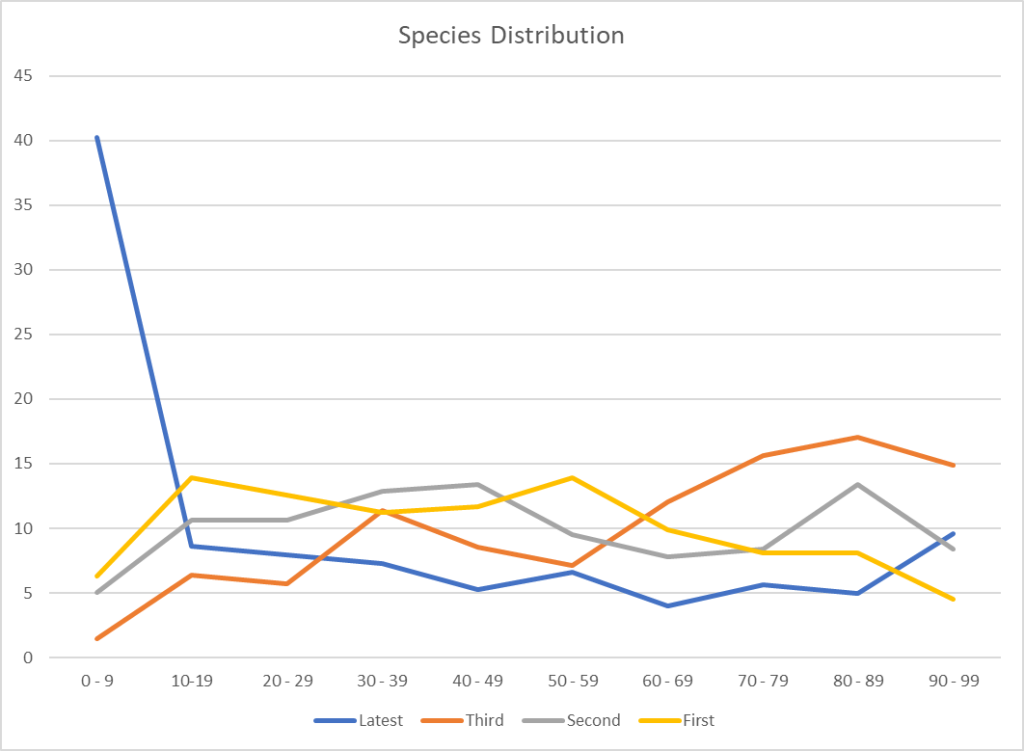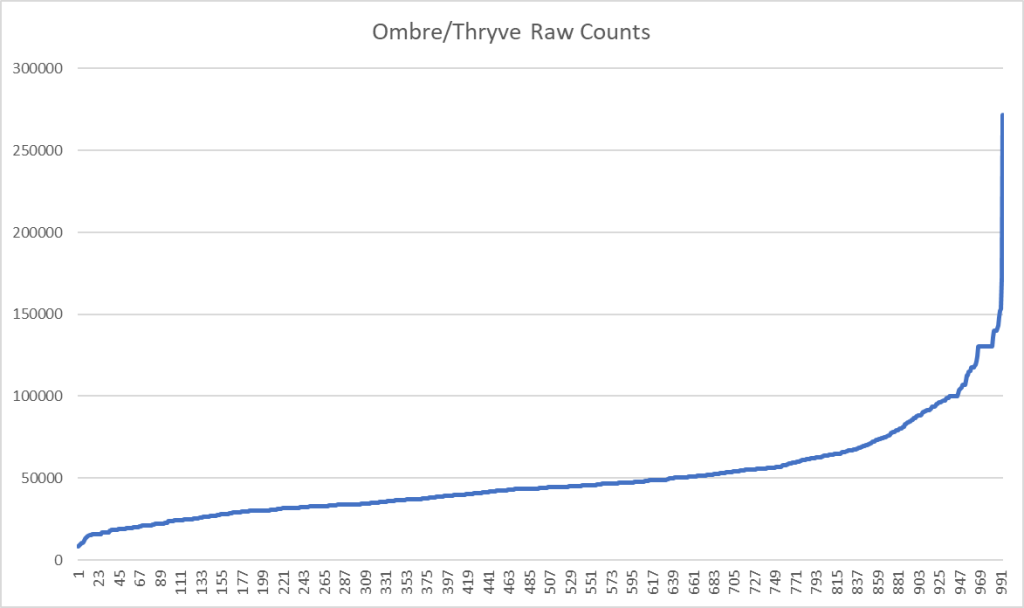Foreword – and Reminder
I am not a licensed medical professional and there are strict laws where I live about “appearing to practice medicine”. I am safe when it is “academic models” and I keep to the language of science, especially statistics. I am not safe when the explanations have possible overtones of advising a patient instead of presenting data to be evaluated by a medical professional before implementing.
I cannot tell people what they should take or not take. I can inform people items that have better odds of improving their microbiome as a results on numeric calculations. I am a trained experienced statistician with appropriate degrees and professional memberships. All suggestions should be reviewed by your medical professional before starting.
The Next Episode of the Story
This person’s early analysis is at IBS + BioNTech COVID Vaccine -> ME/CFS? He forwarded these notes:
- I have done everything as planned since your first review
- I maybe went up from 15% to 20%. I was able to reintroduce some new activities, but still am lying in bed most of the time. Also taking piracetam seems to help.
- I still won’t be able to do the analysis myself.
- COMMENT: ME/CFS patients are a priority for me because I personally understand their brain fog and cognitive impairments from past experiences.
- I have had COVID in the meantime in case that matters for your analysis, but I did not notice any changes afterwards.
Analysis
Given the recent post for another ME/CFS person who had COVID too, with the result that their microbiome became a good match for long COVID and a poor match for ME/CFS, this was my first question. Fortunately, the sample was done via Biomesight, he did not needed with FASTQ files and transferring them. To keep the story short, I looked at his shifts compared to annotated sampled and compare to literature from the US National Library of Medicine nothing shifted between the samples. There is no shift towards Long COVID from ME/CFS in this case.
Comparing Samples
I do not know the answers. I have a model. Models often need adjustments so comparing samples (for better or worst) in a consistent manner is part of my learning process.
First thing we see a dramatic change with rare bacteria being seen much more often and common bacteria less often. There are more genus seen (184 vs 141) and more Species (230 vs 161) but this may be due the better sample reads in the latest sample (82,102 reads versus 55,117 reads).
| Percentile | Latest Genus | Latest Species | Earlier Genus | Earlier Species |
| 0 – 9 | 47 | 65 | 2 | 4 |
| 10 – 19 | 23 | 27 | 10 | 16 |
| 20 – 29 | 19 | 16 | 16 | 11 |
| 30 – 39 | 13 | 17 | 12 | 13 |
| 40 – 49 | 15 | 18 | 13 | 14 |
| 50 – 59 | 16 | 17 | 23 | 32 |
| 60 – 69 | 15 | 22 | 14 | 19 |
| 70 – 79 | 17 | 22 | 13 | 14 |
| 80 – 89 | 13 | 16 | 24 | 22 |
| 90 – 99 | 6 | 10 | 14 | 16 |
| Average | 18.4 | 23.0 | 14.1 | 16.1 |
| Std Dev | 11.0 | 15.4 | 6.2 | 7.4 |
- Hawrelak’s criteria was 95.6%ile for both samples.
- Potential Medical Condition dropped from 7 to 1. With Obesity being in common.
- Bacteria deemed Unhealthy increased from 9 to 17. With Collinsella, Dorea, Prevotella bivia, Prevotella copri, Rickettsia, Serratia and various Streptococcus being added and Mogibacterium disappearing. This may be a side-effect of the better sample.
- Kegg Probiotics
- The maximum value went down from 18.45 to 4.61 (indicating less compound are an extremely low level).
- There were 6 compound listed before and it dropped to just 1 (Aromatic aldehyde) when using 1% filtering level.
- There were 18 compound listed before and it dropped to just 1 when using 5% filtering level.
- There were 19 compound listed before and it dropped to just 3 when using 10% filtering level.
- The maximum value went down from 18.45 to 4.61 (indicating less compound are an extremely low level).
Was there improvement? Despite the potential confusion because of sample quality we had 3 indicators of improvement:
- Significantly less matches to known medical conditions profiles
- Significantly less compound that the person appears to be low in (using data derived from Kyoto Encyclopedia of Genes and Genomes )
- The person feeling subjectively better and doing more activities
Most of the other measures are the same or difficult to interpret. There is one possible concern, the high levels of Prevotella copri is an indicator of mycotoxin, typically from moulds and fungi. Considering that the time between the samples was winter with close windows and heating — there could be an environment issues here – so lots of fresh air may be good.
Over to Suggestions
There are various algorithms to suggesting probiotics, the strongest results are for:
- From KEGG
- At 10% Filtering: Prescript-Assist®/SBO Probiotic – and I would be find substituting Equilibrium as an alternative here.
- At 1%, 5% – any of the following (remember we are short of one compound only and all of there produces it)
- I ran a few ways of picking bacteria based on Bacteria (and not genes) and lactobacillus casei kept was the top in the consensus report (overall and in terms of probiotics)
Doing my usual consensus building
- Use JasonH (15 Criteria) – 7 bacteria
- Standard Lab Ranges (+/- 2 Std Dev) – 6 bacteria
- Box Plot Whisker – 48 bacteria
- Kaltoft-Moltrup Normal Ranges – 56 bacteria
- Percentile in top or bottom 10 % – 66 bacteria
Among the top items are ones that are supported for ME/CFS in studies, including:
- Cacao [2010]
- lactobacillus casei [2009] [2018]
- resveratrol (grape seed/polyphenols/red wine) [2011]
- magnesium [many, going back to the Lancet in 1991 ]
- Cyanocobalamin (Vitamin B-12) [2015 et al]
- folic acid,(supplement Vitamin B9) [2015 et al]
- zinc [2021]
- melatonin supplement [2021]
Unfortunately, some of the items have no studies. Given that the suggestions are based solely on bacteria with no knowledge of the diagnosis, the convergence with the literature suggests that the suggestions are very appropriate. Two different roads came to the same conclusion. In data science this is sometimes called “cross validation”. In Scotland, “O ye’ll tak’ the high road, and I’ll tak’ the low road,
And I’ll be in Scotland a’fore ye,”
I looked at the antibiotic list for the latest sample and the top two are typically used for ME/CFS:
- metronidazole [British Medical Journal] [Patient Survey]
- macrolide antibiotics [2006] [2011]
And interesting that several others often used are NOT recommended: azithromycin (which is a macrolide ?!?), minocycline [2021], fluoroquinolone, doxycycline.
ME/CFS is a heterogeneous condition with a wide variety of microbiome dysfunctions. I believe that using the microbiome to target the best candidate antibiotics is the rational way to proceed.
Questions and Answers
- Question: Sadly I do not tolerate chocolate, but I will try it out again.
- Answer: These are suggestions, do only what you are comfortable with. Nothing is required. The chocolate issue is interesting, my daughter does not tolerate most chocolates, she discovered that it was the type of sugar (i.e. made with liquid sugar / liquid glucose — adverse reaction) made with solid sugar — happiness. See Health effects of glucose syrup
- If you try again, you may wish to determine the type of sugar actually being used first.
- Question: Is there no avoid list?
- Answer: Yes, in the download, any item with a NEGATIVE value in the priority is an avoid

- Question: Is 1 capsule of Equilibrium per day really enough?
- Answer: I honestly do not know. There is no literature to work from. If you take more, than separate them (i.e. 12 hrs apart)
- Question: It seemed whenever I took turmeric that I was getting more nervous and anxious. Still take it now and then?
- Answer: As above, do only what you are comfortable with — there are hundreds of items listed. Anxiety is contrary to the effects of turmeric / curcumin reported in the literature [2021] [2019] [2018] [2017]. If turmeric is causing die-off of bacteria that causes vascular constriction, that would result in anxiety. If you tolerate aspirin or niacin (flushing type), then try taking those with the turmeric.













Recent Comments